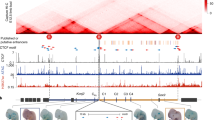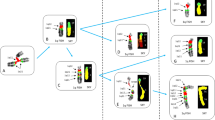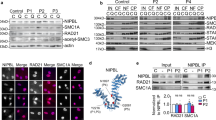Abstract
We have shown previously that chromosomal translocations involving chromosome 3q27 and immunoglobulin gene regions are the third most common specific translocations in non–Hodgkin's lymphoma (NHL). We now report the isolation of a gene that is disrupted in two cases by t(3;14) and t(3;4) translocations. The gene (LAZ3) encodes a 79 kDa protein containing six zinc–finger motifs and sharing amino–terminal homology with several transcription factors including the Drosophila tramtrack and Broad–complex genes, both of which are developmental transcription regulators. LAZ3 is transcribed as a 3.8 kb message predominantly in normal adult skeletal muscle and in several NHL carrying 3q27 chromosomal defects. We suggest that it may act as a transcription regulator and play an important role in lymphomagenesis.
This is a preview of subscription content, access via your institution
Access options
Subscribe to this journal
Receive 12 print issues and online access
$209.00 per year
only $17.42 per issue
Buy this article
- Purchase on Springer Link
- Instant access to full article PDF
Prices may be subject to local taxes which are calculated during checkout
Similar content being viewed by others
References
Rabbits, T.H. Translocations, master genes, and differences between the origins of acute and chronic leukemias. Cell 67, 641–644 (1991).
Lewin, B. Oncogenic conversion by regulatory changes in transcription factors. Cell 64, 303–312 (1991).
Cleary, M.L. Oncogenic conversion of transcription factors by chromosomal translations. Cell 66, 619–622 (1991).
Nichols, J. & Nimer, D. Transcription factors, translocations, and leukemias. Blood 80, 2953–2963 (1992).
Leder, P. et al. Translocations among antibody genes in human cancer. Science 222, 765–771 (1983).
Fukuhara, S., Rowley, J.D., Variakojis, D. & Golomb, H.M. Chromosome abnormalities in poorly differentiated lymphocytic lymphoma. Cancer Res. 39, 3119–3128 (1979).
Manolova, Y., Manolov, Q., Kieler, J., Levan, A. & Klein, G. Genesis of the 14q+ marker in Burkitt's lymphoma. Hereditas 90, 5–10 (1979).
Lenoir, G.M., Preud'homme, J.L., Bernheim, A. & Berger, R. Correlation between immunoglobulin light chain expression and variant translation in Burkitt's lymphoma. Nature 298, 474–476 (1982).
Bastard, C. et al. Translocations involving band 3q27 and Ig gene regions in non-Hodgkin's lymphoma. Blood 79, 2527–2531 (1992).
Deweindt, C. et al. Cloning of a breakpoint cluster region at band 3q27 involved in human non-Hodgkin's lymphoma. Genes Chrom. Cancer (in the press).
Evans, R.M. & Hollenberg, S.M. Zinc fingers: gilt by association. Cell 52, 1–3 (1988).
Lichter, P., Bray, P., Ried, T., Dawid, I.B. & Ward, D.C. Clustering of C2-H2 zinc finger motif sequences within telomeric and fragile site regions of human chromosomes. Genomics 13, 999–1007 (1992).
Harrison, S.D. & Travers, A.A. The tramtrack gene encodes a Drosophila finger protein that interacts with the ftz transcriptional regulatory region and shows a novel embryonic expression pattern. EMBO J. 9, 207–216 (1990).
DiBello, P.R., Withers, D.A., Bayer, C.A., Fristrom, J.W. & Guild, G.M. The Drosophila Broad-Complex encodes a family of related proteins containing zinc fingers. Genetics 129, 385–397 (1991).
Chardin, P., Courtois, G., Mattei, M.G. & Gisselbrecht, S. The KUP gene, located on human chromosome 14, encodes a protein with two distant zinc fingers. Nucl. Acids Res. 19, 1431–1436 (1991).
Koonin, E.V., Senkevich, T.G. & Chernos, V.I. A family of DNA virus genes that consists of fused portions of unrelated cellular genes. Trends Biochem. 17, 213–214 (1992).
Read, D. & Manley, J. Alternative transcripts of the Drosophila tramtrack gene encode zinc finger proteins with distinct DNA binding specificities. EMBO J. 11, 1035–1044 (1992).
Kakizuka, A. et al. Chromosomal translocation t(15;17) in human acute promyelocytic leukemia fuses RARα with a novel putative transcription factor. Cell 66, 663–674 (1991).
de Thé, H. et al. The PML-RARα fusion mRNA generated by the t(15;17) translocation in acute promyelocytic leukemia encodes a functionally altered RAR. Cell 66, 675–685 (1991).
Morishita, K. et al. Retroviral activation of a novel gene encoding a zinc finger protein in IL-3-dependent myeloid leukemia cell lines. Cell 54, 831–840 (1988).
Fichelson, S. et al. Evi-1 expression in leukemic patients with rearrangements of the 3q25-q28 chromosomal region. Leukemia 6, 93–99 (1992).
McGuire, E.A. et al. The t(11 ;14)(p15;q11) in a T-cell acute lymphoblastic leukemia cell line activates multiple transcripts, including Ttg-1, a gene encoding a potential zinc finger protein. Molec. cell. Biol. 9, 2124–2132 (1989).
Djabali, M. et al. A trithorax-like gene is interrupted by chromosome 11q23 translocations in acute leukaemias. Nature Genet. 2, 113–118 (1992).
Tkachuk, D.C., Kohler, S. & Cleary, M.L. Involvement of a homolog of Drosophila Trithorax by 11q23 chromosomal translocations in acute leukemias. Cell 71, 691–700 (1992).
Gu, Y. et al. The t(4; 11) chromosome translocation of human acute leukemia fuses the ALL-1 gene, related to Drosophila trithorax, to the AF-4 gene. Cell 71, 701–708 (1992).
Olson, E.N. MyoD family: a paradigm for development. Genes Dev. 4, 1454–1461 (1990).
Ye, B.H., Rao, P.H., Chaganti, R.S.K. & Dalla-Favera, R. Cloning of bcl6, the locus involved in chromosome translocations affecting band 3q27 in B-cell lymphoma. Cancer Res. 53, 2732–2735 (1993).
Baron, B.W. et al. Identification of the gene associated with the recurring chromosomal translocations t(3;14)(q27;q32) and t(3;22)(q27;q11) in B-cell lymphomas. Proc. natn Acad. Sci. U.S.A. 90, 5262–5266 (1993).
Xiong, W.C. & Montell, C. tramtrack is a transcriptional repressor required for cell fate determination in the Drosophila eye. Genes Dev. 7, 1085–1096 (1993).
Adams, M.D., Kerlavage, A.R., Fields, C. & Venter, C.J. 3,400 new expressed sequence tags identify diversity of transcripts in human brain. Nature Genet. 4, 256–267 (1993).
Author information
Authors and Affiliations
Rights and permissions
About this article
Cite this article
Kerckaert, JP., Deweindt, C., Tilly, H. et al. LAZ3, a novel zinc–finger encoding gene, is disrupted by recurring chromosome 3q27 translocations in human lymphomas. Nat Genet 5, 66–70 (1993). https://doi.org/10.1038/ng0993-66
Received:
Accepted:
Issue Date:
DOI: https://doi.org/10.1038/ng0993-66
This article is cited by
-
Transcriptional programming of translation by BCL6 controls skeletal muscle proteostasis
Nature Metabolism (2024)
-
Chromatin organizer SATB1 controls the cell identity of CD4+ CD8+ double-positive thymocytes by regulating the activity of super-enhancers
Nature Communications (2022)
-
A short guide to histone deacetylases including recent progress on class II enzymes
Experimental & Molecular Medicine (2020)
-
Liver-specific knockout of B cell lymphoma 6 suppresses progression of non-alcoholic steatohepatitis in mice
Scientific Reports (2020)
-
Regulation of hematopoietic development by ZBTB transcription factors
International Journal of Hematology (2016)



